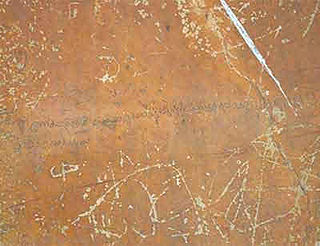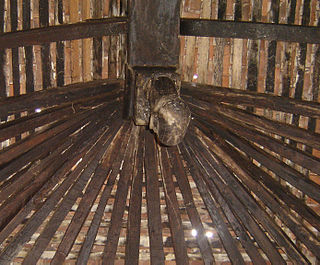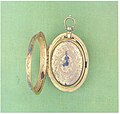
The Sinhalese people, also known as the Sinhalese are an Indo-Aryan ethno-linguistic group native to the island of Sri Lanka. Historically, they were also known as the Helas or the Lion People. They are the largest ethnic group in Sri Lanka, constituting about 75% of the Sri Lankan population and number more than 16.2 million.

The Sinhala script, also known as Sinhalese script, is a writing system used by the Sinhalese people and most Sri Lankans in Sri Lanka and elsewhere to write the Sinhala language as well as the liturgical languages Pali and Sanskrit. The Sinhalese Akṣara Mālāva, one of the Brahmic scripts, is a descendant of the Ancient Indian Brahmi script. It is also related to the Grantha script.

The Western Province is one of the nine provinces of Sri Lanka, the first level administrative division of the country. The provinces have existed since the 19th century but did not have any legal status until 1987 when the 13th Amendment to the Constitution of Sri Lanka established provincial councils. Western Province is the most densely populated province in the country and is home to the legislative capital Sri Jayawardenepura Kotte as well as to Colombo, the nation's administrative and business center.

Sinhala, sometimes called Sinhalese, is an Indo-Aryan language primarily spoken by the Sinhalese people of Sri Lanka, who make up the largest ethnic group on the island, numbering about 16 million. Sinhala is also spoken as the first language by other ethnic groups in Sri Lanka, totalling about 2 million people as of 2001. It is written using the Sinhala script, which is a Brahmic script closely related to the Grantha script of South India.

The Tamil script is an abugida script that is used by Tamils and Tamil speakers in India, Sri Lanka, Malaysia, Singapore, Indonesia and elsewhere to write the Tamil language. It is one of the official scripts of the Indian Republic. Certain minority languages such as Saurashtra, Badaga, Irula and Paniya are also written in the Tamil script.

Provinces are the first level administrative divisions of Sri Lanka. Currently, Sri Lanka is divided into 9 provinces. Each province is further divided into districts, which are further divided into divisional secretariats.

Nimal Mendis (1934–2015) was a Sri Lankan singer and songwriter, and was one of a handful of Sri Lankan musicians to appear on the BBC television programme Top of the Pops (1968). Mendis was a longstanding member of the Performing Rights Society and the Mechanical Copyright Protection Society of Great Britain.
Sri Lankan English (SLE) is the English language as it is used in Sri Lanka, a term dating from 1972. Sri Lankan English is principally categorised as the Standard Variety and the Nonstandard Variety, which is called as "Not Pot English". The classification of SLE as a separate dialect of English is controversial. English in Sri Lanka is spoken by approximately 23.8% of the population (2012 est.), and widely used for official and commercial purposes. Sri Lankan English being the native language of approximately 5400 people thus challenges Braj Kachru's placement of it in the Outer Circle. Furthermore, it is taught as a compulsory second language in local schools from grade one to thirteen, and Sri Lankans pay special attention on learning English both as children and adults. It is considered even today that access and exposure to English from one's childhood in Sri Lanka is to be born with a silver spoon in one's mouth.

The Hindu–Arabic numeral system or Indo-Arabic numeral system is a positional base ten numeral system for representing integers, which can be extended to include non-integers, i.e the Decimal numeral system, which is the most common system for the symbolic representation of numbers in the world.
Several Dhivehi scripts have been used by Maldivians during their history. The early Dhivehi scripts fell into the abugida category, while the more recent Thaana has characteristics of both an abugida and a true alphabet. An ancient form of Nagari script, as well as the Arabic and Devanagari scripts, have also been extensively used in the Maldives, but with a more restricted function. Latin was official only during a very brief period of the Islands' history.
Sinhalisation is a term, derived from Sinhala, that has number of meanings in Sri Lanka. it is mainly the assimilation into Sinhalese Culture in which the members of an ethno-cultural group are steadily integrated or "absorbed" into established Sinhalese culture.

British Ceylon, officially British Settlements and Territories in the Island of Ceylon with its Dependencies from 1802 to 1833, then the Island of Ceylon and its Territories and Dependencies from 1833 to 1931 and finally the Island of Ceylon and its Dependencies from 1931 to 1948, was the British Crown colony of present-day Sri Lanka between 1796 and 4 February 1948. Initially, the area it covered did not include the Kingdom of Kandy, which was a protectorate, but from 1817 to 1948 the British possessions included the whole island of Ceylon, now the nation of Sri Lanka.
Sri Lankan Malay is a creole language spoken in Sri Lanka, formed as a mixture of Sinhala and Shonam, with Malay being the major lexifier. It is traditionally spoken by the Sri Lankan Malays and among some Sinhalese in Hambantota. Today, the number of speakers of the language have dwindled considerably but it has continued to be spoken notably in the Hambantota District of Southern Sri Lanka, which has traditionally been home to many Sri Lankan Malays.

The Kingdom of Kandy was a monarchy on the island of Sri Lanka, located in the central and eastern portion of the island. It was founded in the late 15th century and endured until the early 19th century.
Sinhala language software for computers have been present since the late 1980s but no standard character representation system was put in place which resulted in proprietary character representation systems and fonts. In the wake of this CINTEC introduced Sinhala within the UNICODE standard. ICTA concluded the work started by CINTEC for approving and standardizing Sinhala Unicode in Sri Lanka.
Vedda is an endangered language that is used by the indigenous Vedda people of Sri Lanka. Additionally, communities such as Coast Veddas and Anuradhapura Veddas who do not strictly identify as Veddas also use words from the Vedda language in part for communication during hunting and/or for religious chants, throughout the island.

The British Ceylon period is the history of Sri Lanka between 1815 and 1948. It follows the fall of the Kandyan Kingdom into the hands of the British Empire. It ended over 2300 years of Sinhalese monarchy rule on the island. The British rule on the island lasted until 1948 when the country regained independence following the Sri Lankan independence movement.

Kaṭapayādi system of numerical notation is an ancient Indian alphasyllabic numeral system to depict letters to numerals for easy remembrance of numbers as words or verses. Assigning more than one letter to one numeral and nullifying certain other letters as valueless, this system provides the flexibility in forming meaningful words out of numbers which can be easily remembered.
Alphasyllabic numeral systems are a type of numeral systems, developed mostly in India starting around 500 AD. Based on various alphasyllabic scripts, in this type of numeral systems glyphs of the numerals are not abstract signs, but syllables of a script, and numerals are represented with these syllable-signs. On the basic principle of these systems, numeric values of the syllables are defined by the consonants and vowels which constitute them, so that consonants and vowels are - or are not in some systems in case of vowels - ordered to numeric values. While there are many hundreds of possible syllables in a script, and since in alphasyllabic numeral systems several syllables receive the same numeric value, so the mapping is not injective.

Madol Kurupawa is a wooden king post or catch pin, which is used to secure numerous wooden beams of a roof structure to a single point. It is a unique feature of Kandyan architecture/joinery.



























